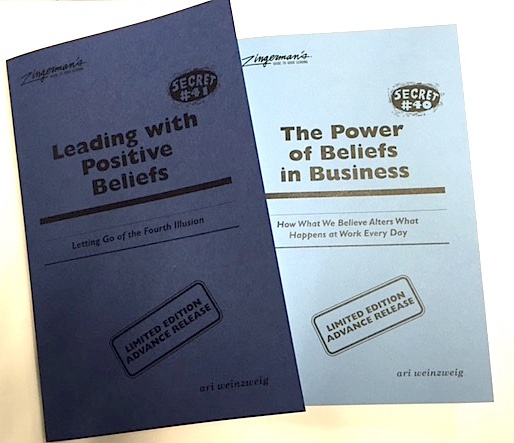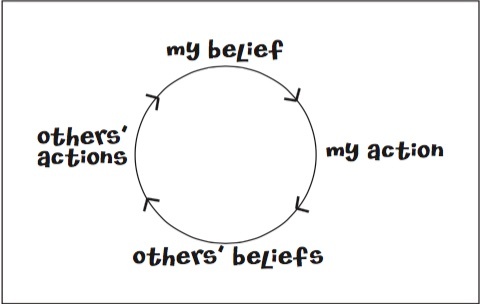|
|
|
|
|
|
|
|
|
|
|
Hello there!
As I write this, Zingerman's is buzzing with Beliefs! I'm sure your business is too. As are you! But more on that in a minute ...
Since Ari started writing his next book, Zingerman’s Guide to Good Leading, Part 4: A Lapsed Anarchist’s Approach to The Power of Beliefs in Business, we've had Belief on our minds. We've realized how powerful Beliefs truly are and how much they affect our business - in our day-to-day work and our larger, longer organizational trajectory. In fact, we've just embarked on a journey to write a statement of our own Beliefs as an organization. Turns out it's pretty deep and soul-searching kind of stuff.
 Even though the book won't be out until June, we're so very ready to share the idea with you. We've got a couple of new Pamphlets out - an advance release of 2 chapters from the book. What follows is an excerpt from one of those Pamphlets. Even though the book won't be out until June, we're so very ready to share the idea with you. We've got a couple of new Pamphlets out - an advance release of 2 chapters from the book. What follows is an excerpt from one of those Pamphlets.
I believe the extract, the Pamhplets and the book when it's available, could change the way you see pretty much everything!

- Gauri Thergaonkar, ZingTrain Community Builder
Excerpted and adapted from:
Zingerman's Guide to Good Leading, Part 4
A Lapsed Anarchist's Approach to
The Power of Beliefs in Business!
Extracted from the introduction to Secret #40
 Beliefs may be the biggest single force at work in our organizational lives. Economics, education, the environment, and employee engagement are all important, but beneath the surface level discussion, most of what’s in play is really about the beliefs of the various folks whose views are being bandied about. While everyone has some beliefs that they’re conscious of—politics, religion, sports, and popular social issues seem to provoke speedy expressions of support or scorn—we actually have far, far more beliefs at play in our lives than that. The difficulty is that those beliefs are frequently framed as facts, certitudes, thoughts, theories, norms, shoulds, and should nots. Most of us fail to recognize them for the beliefs they are. They’re down there in the dirt, below the surface, sitting solidly in our subconscious minds. Many are so far below our levels of consciousness that we never even realize we have them. Whether we know it or not, though, our beliefs are almost always calling the shots. As William James wrote: “Belief creates the actual fact.” Beliefs may be the biggest single force at work in our organizational lives. Economics, education, the environment, and employee engagement are all important, but beneath the surface level discussion, most of what’s in play is really about the beliefs of the various folks whose views are being bandied about. While everyone has some beliefs that they’re conscious of—politics, religion, sports, and popular social issues seem to provoke speedy expressions of support or scorn—we actually have far, far more beliefs at play in our lives than that. The difficulty is that those beliefs are frequently framed as facts, certitudes, thoughts, theories, norms, shoulds, and should nots. Most of us fail to recognize them for the beliefs they are. They’re down there in the dirt, below the surface, sitting solidly in our subconscious minds. Many are so far below our levels of consciousness that we never even realize we have them. Whether we know it or not, though, our beliefs are almost always calling the shots. As William James wrote: “Belief creates the actual fact.”
From Secret #40
What you Believe Is (All Too Often) What You Get: Bob and Judith Wright's Self - Limiting Belief Cycle
If you take the word “belief ” and swap around the second “e” and the “f,” you get “be life”: our beliefs are the basis for the way our lives are going and are going to go in the future. Whether we realize it or not, what we believe in our heads is highly likely to happen in the world around us. Good beliefs often beget good outcomes. If we believe things are going to be bad, it’s likely that they will be. In which case it will be as authors Bob and Judith Wright tell us in their very fine book Transformed! : “In fact, what we believe limits our reality and keeps us from realizing our potential. We think, This is how it is, this is who I am, rather than This is how I’m programmed, this is what I believe, but it is not necessarily the full truth. It causes us to believe, I can’t be assertive like that or I’m kind and thoughtful; I can’t be angry.” Let me elaborate with a visual model that I learned from the Wrights. I give them full credit for the construct, and I share it here with their permission and active support (and my recommendation to buy their books and check out their work at the Wright Institute in Chicago). It connected for me as soon as I read it, and it has already helped thousands of others that we’ve shared it with here at work and through ZingTrain.

It works like this: When we have a belief, it’s likely that belief will lead us to take some sort of associated action. For instance, let’s say we believe that our ideas aren’t worth much and no one really cares about what we think. The action that follows might be that we rarely voice our views at work. That behavior will likely feed the belief in others that we have little to offer, or perhaps aren’t very committed to the company’s success. Which will then lead those coworkers to take action accordingly—they might not ask us for our views on important issues or include us in discussions. Which will then reinforce our original belief that others don’t value our views.
The cycle will surely continue onward from there. Imagine what it will feel like after 20 or 30 years. We start to believe that the reality we’re experiencing is “who we are” rather than a result of how our beliefs have been acting steadily—if surreptitiously—on our reality. We know from studies of brain change and development that when we think in a certain way for a long period of time, the “routes” in our brain grow ever more deeply embedded. The deeper they get, the more we follow along the same path onto which our beliefs long ago led us. And on and on the cycle goes, each element reinforcing the existing beliefs of others in the cycle. As author, psychologist, and professor of social theory at Swarthmore Barry Schwartz says, “These effects can arise because sometimes when people act on the basis of ideology, they inadvertently arrange the very conditions that bring reality into correspondence with the ideology.”
All of which made clear to me how we each contribute to our own crises—both of conscience and of construct. It showed me that if I was frustrated with an action taken by others, I would do well to look away from them and turn back instead to inspect my own beliefs about the subject because, quite simply, our own beliefs are very often the cause of actions we don’t like by others. Most importantly, it showed me that if I wanted to alter the outcomes I was getting in any situation, I would do well to begin by checking out my own beliefs about the other person, myself, and the world. Mindful effort, effective understanding, and consistent practice over an extended period of time can reverse the cycle. The change starts with a decision to adopt a new belief, or if you’re thinking big, a whole new set of them.
In the scenario above, we might decide to change our belief by telling ourselves, “What I have to say does have value.” Although it may be awkward and difficult at first, we start to act on this new belief. Rather than withhold our thoughts, we start to constructively share with others. As we do, people begin to believe that we have more to offer than they might have originally thought. In turn, their new belief will change their actions—they now start to ask for our opinion more often. That action begins to impact what we believe about ourselves, and our self-image slowly but surely starts to improve. Over time, we might become one of the most well-thought-of thinkers in the group.
Having become mindful of this dynamic since reading the Wrights’ work, I can identify any number of situations in which I’ve unintentionally done damage to myself and to others around me over the years. Damn if I didn’t contribute quantitatively to my own demise! Our beliefs, in that context, are part of what’s called a “reflexive reality”—what happens around us is altered by our belief about what’s going on, which only reinforces our beliefs. If we believe our boss is out to get us, we’re on edge; our work quality decreases from the anxiety; the boss reads our uncertainty as apathy or a lack of commitment and begins to invest time in others, which just reinforces our belief that the boss is trying to be done with us.
Just recognizing the nature of this simple cycle is incredibly powerful. Our beliefs lead us to take certain actions, which inform the beliefs of others, which lead them to almost always act in ways that reinforce our original beliefs. It’s what Claude Bristol wrote over half a century ago in The Magic of Believing: “Every person is the creation of himself, the image of his own thinking and believing. As individuals think and believe, so they are.”
 From Secret #40 From Secret #40
An exercise to help you understand your own beliefs and their power
Pick a belief. Any belief. About your business. The world. Yourself. Take a minute or two and try to track it back to the beginning. Who planted the seed? What happened to reinforce and strengthen the roots that grew from it? How long have you held it? Do you know anyone who holds a different belief about the same subject? What impact is the belief having on your life? If you held the opposite belief, what sort of things would you be doing differently?
Want to read more? Don't want to wait till June?
We have two advance Pamphlets for you! Besides going in depth into the ideas in this e-news, the Pamphlets are beautiful! They're printed on sustainable paper, saddle stitched, and include a hand-laid scratch-board illustration.
SECRET #40
The Power of Beliefs in Business; How What We Believe Alters What Happens at Work Every Day
SECRET #41
Leading with Positive Beliefs; Letting Go of the Fourth Illusion
|
|
|
|
|
|
|